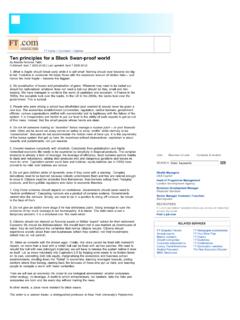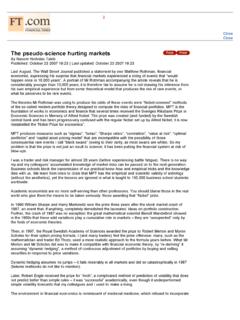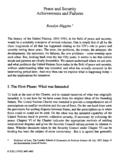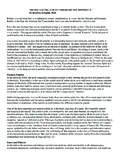Transcription of REAL WORLD RISK INSTITUTE WORKING PAPER SERIES What …
1 REAL WORLD RISK INSTITUTE WORKING PAPER SERIES1 What are the chances of a third WORLD war?Pasquale Cirillo and Nassim Nicholas TalebTo appear [a recent] issue ofSignificanceMr. Peter McIntyre askedwhat the chances are that WORLD War III will occur Michael Spagat wrote that nobody knows, nobody canreally answer and we totally agree with him on this. Thenhe adds that "a really huge war is possible but, in my view,extremely unlikely." To support his statement, Prof. Spagatrelies partly on the popular science work of Prof. StevenPinker, expressed in The Better Angels of our Nature andjournalistic venues.
2 Prof. Pinker claims that the WORLD hasexperienced a long-term decline in violence, suggesting astructural change in the level of belligerence of is unfortunate that Prof. Spagat, in his answer, refers toour PAPER [1], which is part of a more ambitious project weare WORKING on related to fat-tailed characterizes fat tailed variables? They have theirproperties (such as the mean) dominated by extreme events,those "in the tails". The most popularly known version is the"Pareto 80/20".We show that, simply, data do not support the idea of astructural change in human belligerence.
3 So Prof. Spagat sfirst error is to misread our claim: we are making neitherpessimistic nor optimistic declarations: we just believe thatstatisticians should abide by the foundations of statisticaltheory and avoid telling data what to us go back to first PrinciplesFundamentally, statistics is about ensuring people do notbuild scientific theories from hot air, that is without significantdeparture from random. Otherwise, it is patently "fooled byrandomness".Further, for fat tailed variables, the conventional mechanismof the law of large numbers is considerably slower andsignificance requires more data and longer periods.
4 Ironically,there are claims that can be done on little data: inference isasymmetric under fat-tailed require more datato assert that there are no black swans than to assert thatthere are black swanshence we would need much more datato claim a drop in violence than to claim a rise in it [2].Finally, statements that are not deemed statistically signifi-cant and shown to be so should never be used to constructscientific foundational principles are often missed because,typically, social scientists statistical training is limited tomechanistic tools from thin tailed domains [2].
5 In physics,one can often claim evidence from small data sets, bypassingstandard statistical methodologies, simply because the variancefor these variables is low. The higher the variance, the moredata one needs to make statistical claims. For fat-tails, thevariance is typically high and underestimated in past second more serious error Spagat and Pinker madeis to believe that tail events and the mean are somehowdifferent animals, not realizing that the mean includes these fat-tailed variables, the mean is almost entirelydetermined by extremes. If you are uncertain about the tails,then you are uncertain about the mean.
6 It is thus incoherentto say that violence has dropped but maybe not the risk oftail events; it would be like saying that someone is "extremelyvirtuous except during the school shooting episode when hekilled 30 students".RobustnessOur study tried to draw the most robust statistical picture ofviolence, relying on methods from extreme value theory andstatistical methods adapted to fat tails. We also put robustnesschecks to deal with the imperfection of data collected somethousand years ago: our results need to hold even if a third(or more) of the data were timesWe show that the inter-arrival times among major conflictsare extremely long, and consistent with a homogenous Poissonprocess: therefore no specific trend can be established: we ashumans can not be deemed as less belligerent than usual.
7 For aconflict generating at least 10 million casualties, an event lessbloody than WW1 or WW2, the waiting time is on average136 years, with a mean absolute deviation of 267 (or 52 yearsand 61 deviations for data rescaled to today s population). Theseventy years of what is called the "Long Peace" are clearlynot enough to state much about the possibility of WW3 in thenear of the meanWe also found that the average violence observed in thepast underestimates the true statistical average by at least Consider that about 90-97% of the observations fallbelow the mean, which requires some corrections with thehelp of extreme value theory.
8 (Under extreme fat tails, thestatistical mean can be closer to the past maximum observationthan sample average.)A common mistakeSimilar mistakes have been made in the past. In 1860, Buckle used the same unstatistical reasoning as Pinkerand WORLD RISK INSTITUTE WORKING PAPER SERIES2 That this barbarous pursuit is, in the progressof society, steadily declining, must be evident, evento the most hasty reader of European history. If wecompare one country with another, we shall find thatfor a very long period wars have been becomingless frequent; and now so clearly is the movementmarked, that, until the late commencement of hos-tilities, we had remained at peace for nearly fortyyears: a circumstance unparalleled (.)
9 The questionarises, as to what share our moral feelings have hadin bringing about this great feelings or not, the century following Mr. Buckle sprose turned out to be the most murderous in human conclude by saying that we find it fitting and arehonored to expose fundamental statistical mistakes in ajournal calledSignificance, as the problem is precisely aboutsignificance and conveying notions of statistical rigor to thegeneral [1] Cirillo P., Taleb (2016), On the statistical prop-erties and tail risk of violent A: StatisticalMechanics and Its Applications.[2] Taleb, (2007),The Black Swan: The Impact of theHighly Improbable, Penguin.
10 [3] Buckle, (1858)History of Civilization in England,Vol. 1, London: John W. Parker and RISK WORKING PAPERSOn the statistical properties and tail risk of violentconflictsPasquale Cirillo , Nassim Nicholas Taleb Applied Probability Group, Delft University of Technology, Tandon School of Engineering, New YorkUniversityAbstract We examine statistical pictures of violent conflictsover the last 2000 years, finding techniques for dealing withincompleteness and unreliability of historical introduce a novel approach to apply extreme value theoryto fat-tailed variables that have a remote, but nonetheless finiteupper bound.












